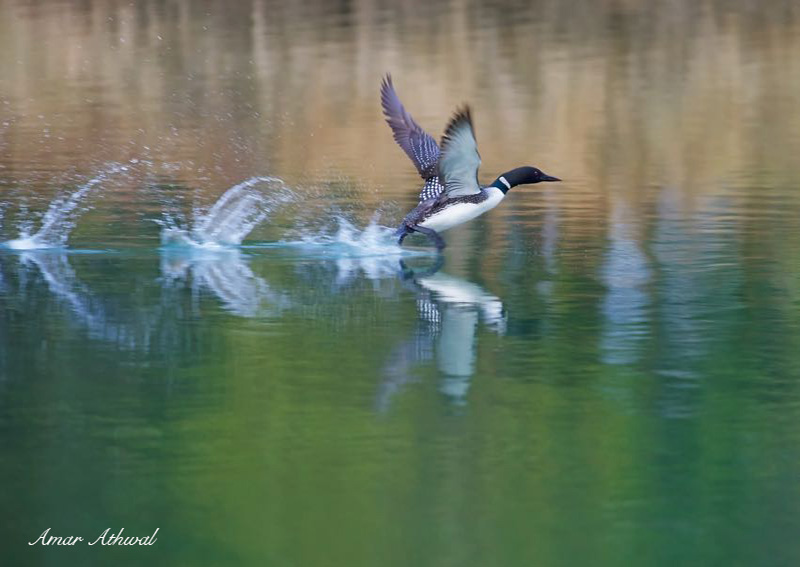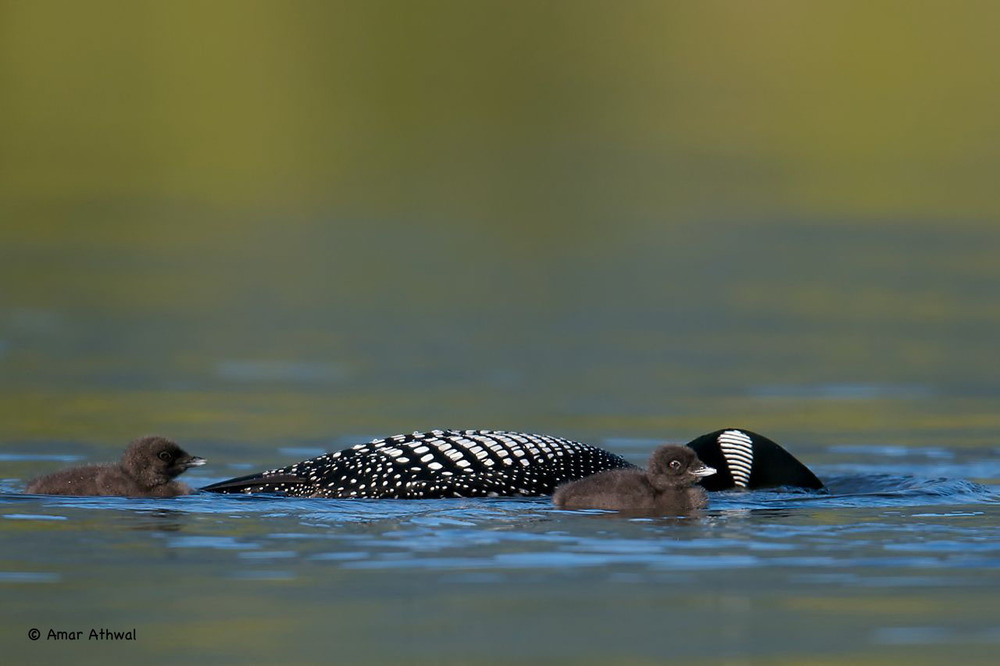The Common Loon is one waterfowl many Canadians are familiar with. Any lake they are successful at, is a great indicator of the quality and the clarity of that water. Thanks to the clear water mountain lakes, more than a few times I have seen what a great swimmer the loons are. Everything about them is designed to be in the water, only time coming out when they are going and coming from their nest. And the nest is always next to the water. Their bones are denser than the bones of other birds, making them less buoyant but very handy for diving. With their legs placed near the back, they are able to move quickly through the water to catch their food. Loon parents and two chicks can put away about 450 kg of fish over a 15-week period.
Common Loon
Not all great athletes made it to the olympic, for example the Common Loon. A fast flyer, it can fly as fast as 120 kilometre per hour. A great diver, has been found as deep as 60 meters below water surface. And the things it can do in water would make any swimmer jealous, these abilities come in handy when you have to catch your food that lives in water. One of the reason it's a great diver is due to its solid bones, makes the loon less buoyant but great for getting below the water surface. The loon is not able to fly right out of water, that's why the loon needs to run on water before getting into air. There is no medal for this loon, it has these and other abilities for one reason and one reason along, to survive.
Until next moment,
Amar
Common Loon
The Common Loon adults did everything they could but still no family this year. The nest could have been disturbed by other animals, forcing the adults off the eggs for too long. Predators were spotted near the nest few times. In the end no young, just the adults hanging out in the lake.
Until next moment,
Amar
Common Loon

This adult Common Loon had landed on the river and swan over to a another adult nearby. Did what looked like a mating ritual, a mirroring behaviour. Then after about five minutes it flew away.
Until next moment,
Amar
Common Loon

In the mornings light, Canada national bird, the Common Loon stretching its wings. One of the joy in the wilderness is hearing their sound, particularly in the morning when human related sounds are not present. Before this picture I heard the calls.
Until next moment,
Amar
Common Loon

Out national bird, the Common Loon, Happy Birthday Canada.
Until next moment,
Amar
My Wait at Herbert Lake

Waiting is a big part of nature photography. From experience, photographer can have some level or accuracy forecasting what may take place, but nature will always have the final say. My hope was to go north of Herbert Lake to take pictures of sunrise and then go for a hike. But the very dark clouds moving in from the west made me pull over into the parking lot by Herbert Lake. The time when sunrise was to take effect came and passed without making a change in the sky, I decided to stand against a tree, waiting and watching the two adult Common Loons feeding the juvenile in the lake.
Then it all started to come together, light coming through creating a wonderful reflection on the still water of the lake and dark clouds creating a dramatic effect. Once I was finish with the landscape, I got a chance to take pictures of the juvenile loon that paid a visit near where I was standing earlier. To end my time at the lake, as I was taking pictures of the loons heavy rain drops start to fall on the still water, creating what sounded like musical notes with each drop.


Until next moment,
Amar
Common Loon

About 10 days ago two Common Loon eggs hatched. I had taken few pictures of the adults when they had returned to the lake and also after the eggs were laid but never had taken pictures of Common Loon chicks. I was given a heads up by a friend about the little ones, or should I say a challenge to get the pictures of the chicks. As a proud Parks Canada's employee I took that challenge, okay I like taking pictures of birds and taking pictures of Loon's chicks would be fun. The first few days, I had no problem with the adults bringing the chicks near me but had very low light with heavy clouds and the on and off rain.
Then one morning I got out there on a mostly sunny day, but the family was some 70 meters from me, two chicks on top of an adult and one adult on its own. I sat down and waited, taking in the beautiful morning.Then an hour later they started to move around, the chicks came off the parent's back, all slowly moving toward me as the parents fed the chicks. They were fed insects and small fishes found in the water. I kept taking pictures after pictures, thinking they were not going to get any closer, but they did. At one time the parents left the chicks about 10 meters from me as they went to the middle of the lake. It was a great morning. Sadly three days after I took the attached picture, one of the chick went missing, perhaps taken by bird looking for a snack. Life is tough in the wild, one day you're eating and another day you're being eaten.
Until next moment,
Amar
Common Loon

In the wild the birds will always have the final say as to how close they will get to me. Best thing for me to do is to find a place and wait, bird are always in control. You have to keep going out to improve your chances getting close. I had already gone several times to the lake to see the Common Loons, they staying far away from me. But one day all that changed, as I saw them go under water and come closer to me each time they came up. I kept taking pictures and hoping they would get even closer. Before I knew it they were too close for me to frame the whole bird, so I started to frame the head of the loons. It's a beautiful bird when calling in the distance, but that beauty only increases when you see the bird close up.
Until next moment,
Amar


